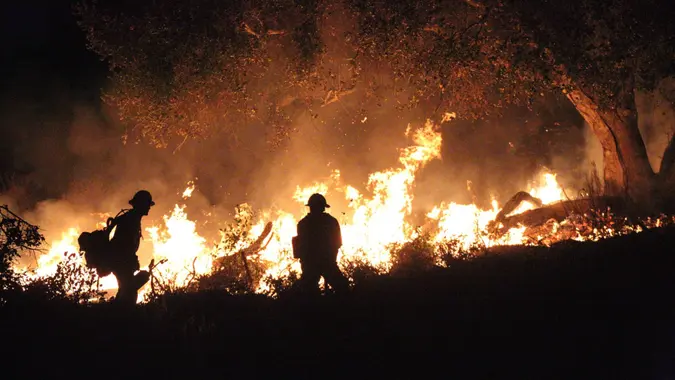7 Things To Know About Grants for Disaster Relief

Commitment to Our Readers
GOBankingRates' editorial team is committed to bringing you unbiased reviews and information. We use data-driven methodologies to evaluate financial products and services - our reviews and ratings are not influenced by advertisers. You can read more about our editorial guidelines and our products and services review methodology.

20 Years
Helping You Live Richer

Reviewed
by Experts

Trusted by
Millions of Readers
Following the devastating fires that have ravaged Los Angeles, displacing 180,000 residents and causing widespread destruction to homes, lives, and businesses, both federal and state agencies have stepped up to provide essential financial aid to those affected.
Read More: The Living Wage a Family of Four Needs in All 50 States
Find Out: 4 Subtly Genius Moves All Wealthy People Make With Their Money
For Californians navigating these tough times, it’s crucial to understand the details of disaster relief grants and their tax implications. Here are seven key points to help you understand the available disaster relief grants.
Disaster Relief Grants Available
Disaster relief grants come in various forms, each designed to address specific needs following a catastrophe:
- FEMA Grants: The Federal Emergency Management Agency (FEMA) offers grants for temporary housing, home repairs, and other critical needs. Applications are typically available online through the FEMA website shortly after a disaster is declared.
- State Government Grants: States have dedicated departments for disaster recovery. For example, California’s Office of Emergency Services (Cal OES) coordinates state-level assistance programs, including financial grants for rebuilding and recovery efforts.
- Non-Profit Organization Grants: Organizations like the American Red Cross provide immediate relief and long-term recovery grants. Local chapters often offer additional funding tailored to specific community needs.
- Local Government Grants: County and city governments may have their own grant programs to address the unique needs of their communities. Contacting local municipal offices or visiting their websites can reveal supplementary funding options.
Eligibility Criteria for Grants
Relief grants are based on the following factors:
- Location: The disaster must be officially declared by federal or state authorities. For example, the 2025 Los Angeles wildfires were federally declared, making residents in affected areas eligible for grants.
- Type of Damage: Grants can cover various losses, including property damage, temporary housing, and business interruptions. Applicants should choose grants that align with their specific needs.
- Financial Need: Applicants must show financial hardship or inability to pay recovery costs through insurance or other resources. Providing documentation of income and expenses is typically required.
Application Process
Securing disaster relief grants involves a systematic approach to ensure eligibility and maximize benefits:
- Document Losses: Thoroughly document all damages and losses with photographs, receipts, and appraisals. Comprehensive documentation is crucial for both grant applications and potential tax deductions.
- File Insurance Claims: Ensure all insurance claims are filed and settled before applying for grants. Only losses not covered by insurance are eligible for additional deductions or grants.
- Submit Applications Promptly: Disaster relief programs often have strict deadlines. Submitting applications as soon as possible increases the likelihood of receiving timely assistance.
- Amend Tax Returns If Necessary: If qualifying for deductions related to disaster losses, taxpayers may need to amend their previous year’s tax returns to reflect these changes. Consulting with a Certified Public Accountant (CPA) can streamline this process.
Tax Implications of Disaster Relief Grants
Understanding the tax treatment of disaster relief grants is vital. Certified Public Accountants (CPAs) recommend maintaining detailed records of all disaster-related expenses and grants received to ensure accurate reporting and compliance with Internal Revenue Service (IRS) requirements:
- Non-Taxable Grants: Grants used directly for disaster-related expenses, such as rebuilding homes or replacing lost property, are typically exempt from federal income tax. This ensures that the financial assistance received is fully available for recovery efforts.
- Taxable Assistance: Certain forms of aid, such as scholarships or grants not specifically designated for disaster relief, may be subject to taxation. Reviewing the terms of each grant is essential to determine its tax status accurately.
Business Relief Options
Businesses affected by disasters also have access to specific relief measures designed to facilitate recovery and continuity:
- Expense Deductions: Businesses can deduct immediate repair and restoration costs, reducing the overall financial impact of the disaster.
- Low-Interest Loans: The Small Business Administration (SBA) offers low-interest loans to help businesses rebuild and recover without incurring excessive debt burdens.
- Tax Incentives for Employee Retention: Businesses may receive credits for wages paid to employees during periods of interruption caused by the disaster, aiding in maintaining workforce stability.
The Role of Certified Public Accountants
With over 80,000 CPAs in California supporting millions of taxpayers, these professionals play a pivotal role in guiding taxpayers through the complexities of disaster tax relief:
- Accurate Record-Keeping: Ensuring all necessary documentation is maintained to support grant applications and tax deductions.
- Tax Return Amendments: Facilitating the amendment of tax returns to include disaster-related deductions and exemptions.
- Representation During Audits: Providing expert representation in case of IRS or state-level audits related to disaster relief claims.
Overcoming Challenges in the Relief Process
While disaster tax relief offers substantial benefits, navigating the application and compliance processes can present challenges. Key strategies to mitigate these hurdles include:
- Staying Informed: Regularly monitor announcements from federal and state authorities regarding disaster declarations and available relief programs.
- Organized Documentation: Maintain organized records of all expenses, losses, and received grants to streamline the application and reporting processes.
- Electronic Filing: Utilize electronic filing methods for faster processing and reduced likelihood of errors in grant applications and tax returns.
Frequently Asked Questions
- Can I deduct personal property losses from wildfires? Yes, you may deduct losses if the event occurred in a federally declared disaster zone and the losses exceed any insurance reimbursements.
- Do I need to provide proof of my losses? Yes, the IRS requires detailed documentation, such as photos, receipts, and insurance claims, to substantiate your deductions.
- Are insurance payouts for wildfire damage taxable? No, most insurance payouts for wildfire-related damages are not taxable.
- How do I report wildfire losses on my taxes? Use Form 4684 to claim wildfire-related casualty losses on your tax return.
- How can I claim wildfire-related tax deductions faster? File an amended return for the prior tax year to expedite refunds for such losses.
 Written by
Written by  Edited by
Edited by 
























